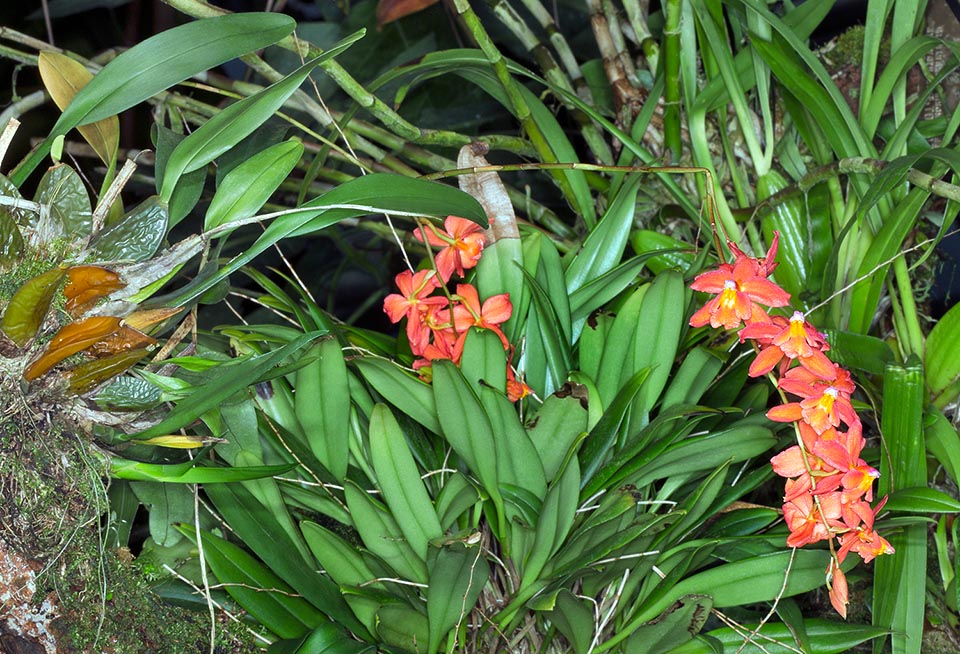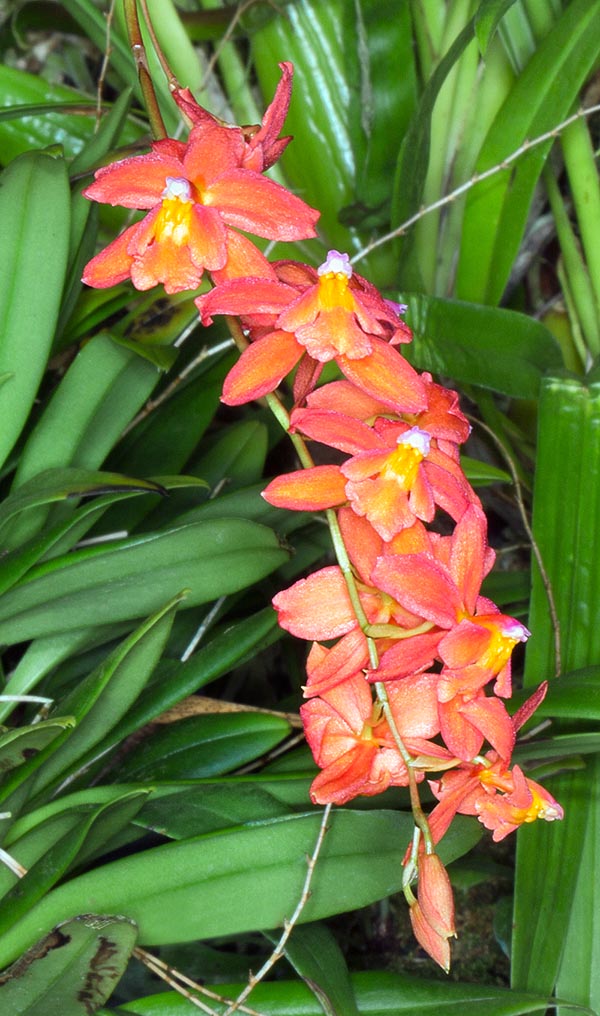Family : Orchidaceae

Text © Pietro Puccio

English translation by Mario Beltramini
The species is native to Bolivia (Cichabamba) and Peru where it lives in the trees of the misty forests between 2000 and 3500 m of altitude.
The name of the genus comes from the Greek “ὄγκος” (onkos) = tumour, mass, plus the diminutive suffix “-ιδιον” (-idion) with reference to the small fleshy growth at the base of the labellum of many species belonging to the genus; the species is dedicated to its collector, the Swiss Jean Nötzli.

The Oncidium noezlianum is a 20-30 cm tall epiphyte of the altitude misty forests of Bolivia and Peru © Giuseppe Mazza

20-25 cm inflorescences. Horticultural hybrids due to the intense orange red colour © Giuseppe Mazza
It reproduces by seed, in vitro, and by division with each section provided of a least 3-4 pseudobulbs.
Species with particularly attractive flowers that has originated several hybrids to which it has granted its intense orange red colour. It is to be cultivated in a slightly shaded location, very aerated, with high humidity, 70-85 %, and cool to intermediate temperatures, with night values between the 7 and 15 °C and daily ones between 15 and 25 °C, with a high daily thermal excursion to encourage the blooming, conditions not always easy to obtain without cooling systems.
During the growth of the pseudobulbs the waterings must be regular, but letting to partially dry up before giving water again, spaced in winter till the appearance of the new vegetation, but without ever allowing to dry up completely, with nebulizations regularly distributed during the whole year. The waterings and the nebulizations are to be done with rain water, by reverse osmosis or demineralized, and the fertilizations, during the vegetative period, with hydrosoluble balanced products, with microelements, at half dosage, or less, than that suggested on the package, distributed and alternated in order to avoid salts accumulation to the roots.
It may be mounted on trunks, bark pieces or rafts or cultivated in pot with particularly draining and aerated compost that can be formed by medium sliced bark fragments and sphagnum, with possible addition of charcoal and inerts. The repottings and possible divisions are to be done at the vegetative restart.
The species is reported in the appendix II of the CITES (species whose trade is internationally ruled).
Synonyms: Cochlioda densiflora Lindl. (1853); Odontoglossum cochlioda Rchb.f. (1864); Mesospinidium densiflorum (Lindl.) Rchb.f. (1872); Cochlioda noezliana (Mast.) Rolfe (1890); Odontoglossum noezlianum Mast. (1890); Cochlioda miniata L.Linden (1896); Cochlioda noezliana var. superba L.Linden (1898); Cochlioda floryi Rolfe (1911); Cochlioda beyrodtiana Schltr. (1919); Cochlioda densiflora f. aurea Roeth & O.Gruss (2003); Oncidium beyrodtioides M.W.Chase & N.H.Williams (2008); Oncidium densiflorum (Lindl.) M.W.Chase & N.H.Williams (2008); Oncidium floryi (Rolfe) M.W.Chase & N.H.Williams (2008); Oncidium miniatum (L.Linden) M.W.Chase & N.H.Williams (2008); Oncidium andinum Molinari (2016).
→ For general notions about ORCHIDACEAE please click here.
